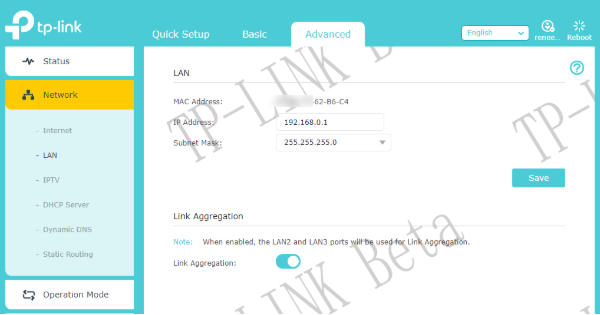How to configure link aggregation on TP-Link Wi-Fi products
Note:The wireless router doesn't support link aggregation under the Access Point Mode.
Introduction: Some TP-Link Wi-Fi products have the Link Aggregation function which can aggregate two LAN ports together at most in order to get a higher LAN speeds up to 2Gbps theoretically.
If you build a NAS server in your local network and require a higher LAN speed than 1Gbps, the device environment could be set as below:

Note: Our products only support layer 2 LACP, don’t support layer 3 or layer 4 LACP.
Step 1:
Login the management page of the supported product.

If needed, you may refer to How do I log into the web-based Utility (Management Page) of TP-Link wireless router? for more detailed information.
Step 2:
Click Advanced, Network, and then LAN.

Step 3:
Select your model number:
For Archer AX6000/AX11000/AX50/C5400X:
Enable the Link Aggregation function, select two LAN ports you want as aggregated ports (the aggregated ports are set to LAN2 and LAN3 on AX6000/AX11000 as default). Then click Save.

For Archer C5400/C3150:
Enable the Link Aggregation function, select the work mode as “LACP active” and select two LAN ports you want as aggregated ports. Then click Save.
For Archer C2300:
Enable the Link Aggregation function, select the work mode as “Static LAG” – “SRC MAC + DST MAC” and select two LAN ports you want as aggregated ports. Then click Save.
Step 4:
Configure the Link Aggregation function on the NAS server.
For Archer AX6000/AX11000/AX50/C5400X/C2300:
Select the work mode as “Balance XOR” or the mode works with a switch that supports Static Link Aggregation.
For Archer C5400/C3150:
Select the work mode as “IEEE 802.3ad Dynamic Link Aggregation” or the mode works with a switch supports IEEE 802.3ad (Dynamic) Link Aggregation (LACP, 802.1AX).
Step 5:
Connect the NAS server to our product as we showed at first.
Step 6:
Make sure the NAS server has received a valid IP address from our product normally. You could check it in DHCP Client List.

Finden Sie diese FAQ hilfreich?
Mit Ihrer Rückmeldung tragen Sie dazu bei, dass wir unsere Webpräsenz verbessern.
Von United States?
Erhalten Sie Produkte, Events und Leistungen speziell für Ihre Region
